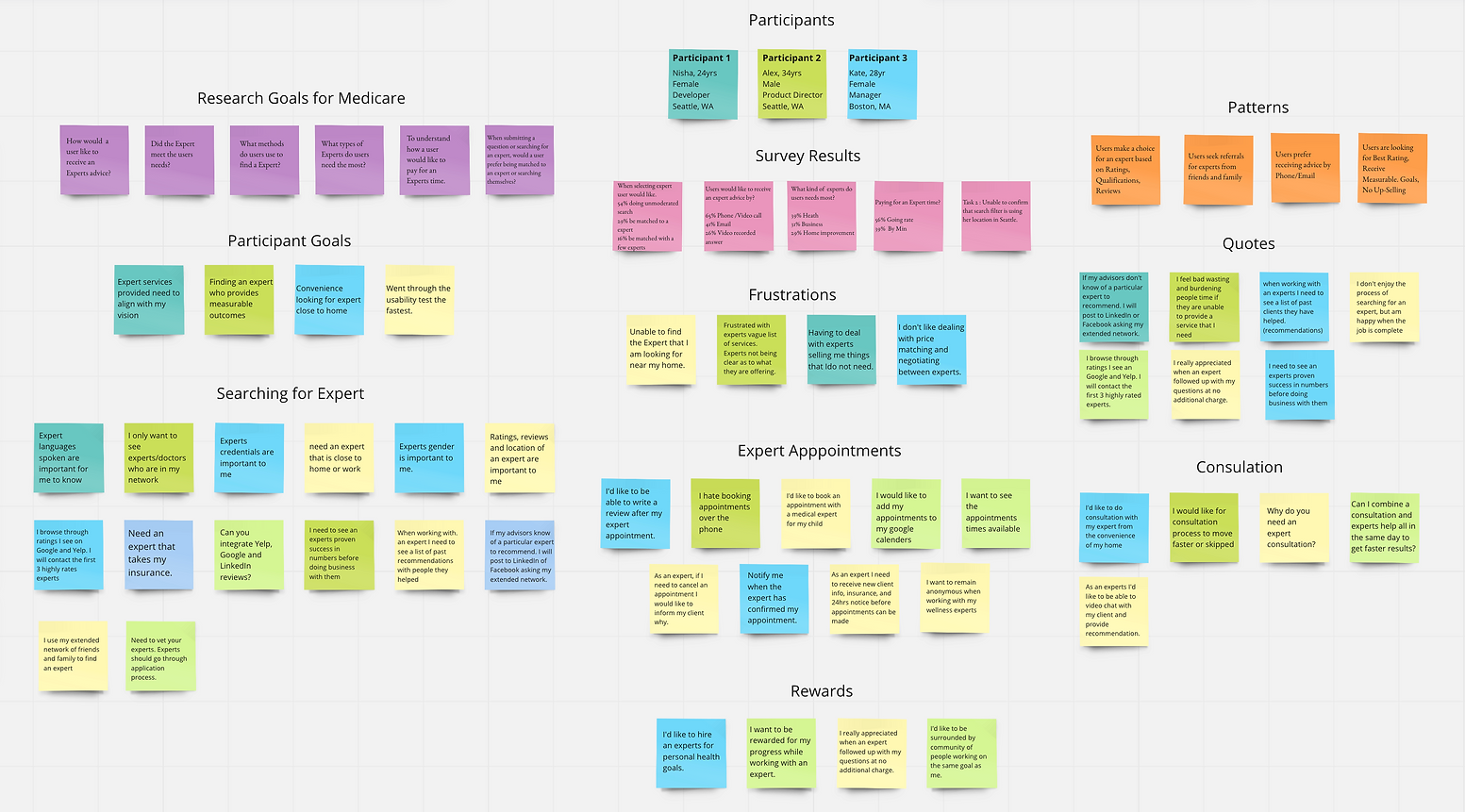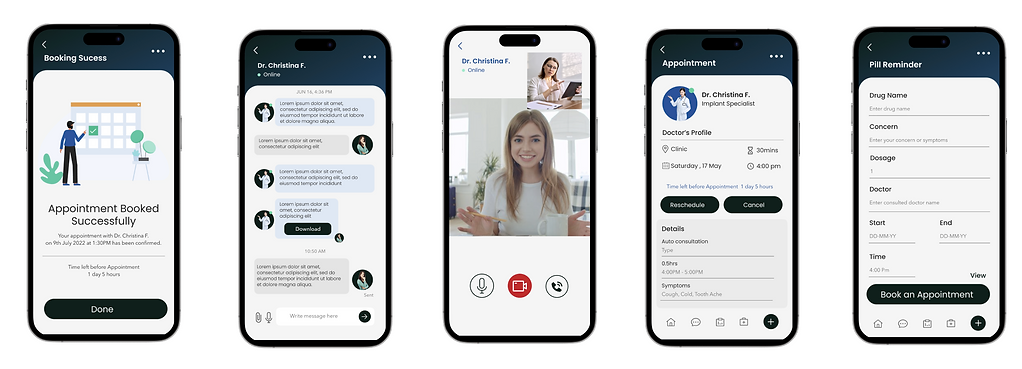
Introduction
-
MediCare is a product that came to life through my UX Design 10-month certified training program.
-
After conducting surveys and user interviews, I learned that there’s a great need for a particular expert product, I pivoted from building a product that would touch all expert categories such as business, home improvement, law, and health to focusing on one expert category.
-
What sets MediCare apart from its competition, is the primary feature, which allows users to have access to an intuitive and reliable MediCare, a health care assistant, that helps answer user questions and connect effortlessly with health and wellness experts who are proficient and highly recommended in their fields.

My role and process
Medicare App is an individual project which allowed me to plan and direct each step of the design thinking process as a UX strategic design student with mobile and web UI design experience.
-
I conducted generative research first to understand my potential users and the complexity of their needs, motivations, and behaviors.
-
This research helped define MediCare’s problem and provided insights to inform the ideation phase.
Design Methodologies
I begin my process with design thinking and gathering generative research through empathy and a deeper understanding of user needs and desires.
-
What does the overall purpose of these elements serve?
-
Do these elements solve my persona’s problems?
Empathize
Surveys and Interviews
To get the project started, I began my research by formulating questions to ask people who need the advice of an expert, but don’t have a friend or family member to call.
-
My target age demographic is 18–40 since younger people are less likely to elicit expert help and older people may be more likely to be turned off by the technology and the virtual call aspect.
-
I kept an open mind and considered everything about my customer by listening to them and learning about the complexity of their needs.

Affinity Map
With the results of my survey and interview research analysis, I synthesized the data collected through the creation of an affinity map.

Click link to View Affinity Map
Key Takeaways
-
Health and wellness is the highest-ranked expert category needed for those seeking expert advice.
-
People more frequently find an expert through a personal network of colleagues, friends and family referrals.
-
My survey results in state that 54% of users search for an expert on their own rather than any other form. That said, in my moderated user interviews 75% of people would rather have someone provide expert recommendations to them rather than research on their own.
-
66% of users would prefer to receive an expert's advice by phone or video call than any other form.
-
People appreciate when experts follow up with their questions after the service has been provided for no additional charge.
-
Having a virtual consultation between the expert and the customer will help speed up the process for receiving help.
-
Providing expert ratings, qualifications, reviews, price, location, and measurable goals are what people are looking for when making a final decision on working with an expert.
-
More than 70% of the time people will check Google and Yelp reviews and ratings even after receiving a referral. How can I incorporate google and yelp ratings and reviews in the app? How can I validate and build trust with the ratings and reviews of an expert?
Define
-
This research helped define MediCare’s problem and provided insights to inform the ideation phase.
-
During the developing process, I moved through the lean feedback loop (build, measure, learn) making design improvements and increasing the usability of my prototype based on moderated usability test, a/b test, and preference testing to finally deliver my finished product and it’s three core features.
_Problem Statement
Health assistance needs - because they are busy and often struggle to use their health insurance web portal to find a health practitioner and schedule an appointment.
_Hypothesis
We will know this to be true when we see how many users are submitting requests to our health assistants and in return, the assistants are able to effectively handle all healthcare needs by providing the best doctor recommendations, available appointments that meet the user's schedule and book their next appointment for them.
_Potential Solutions
-
Develop a competitive industry-specific expert marketplace, a health assistant app, that delivers solutions to patient problems and eliminates the time it takes to find the perfect health expert utilizing a MediCare.
-
The goal of this app is to give people a simple, intuitive way to book with health practitioners in nearly any field quickly by utilizing an informed health assistant so they can stay on top of their annual checkups (and not-so-everyday) health problems.
Ideate
Based on the generative user research I gathered, I created three user personas that capture the essence of my target users. Meet Nisha, Alex, and Kate!
User Personas
User Journey's
By creating persona journey maps, I wanted to illustrate the process of how Nisha, Kate, and Alex behave, feel and think while accomplishing their goals to detect pain points or moments of delight.
User Flows
I built user-focused flows to ensure that my personas can successfully complete their key objectives while reducing the existing pain points
Sitemap V1
-
I created my sitemap; the V1 Sitemap provides more details of the user journey, I took into consideration all the research.
-
I have gathered thus far
-
the user personas,
-
journeys and flows,
-
card sort test,
-
ZocDoc content audit,
-
usability heuristic evaluation.
-
This process helped with informing the structure of my information architecture and how my primary features should be mapped out.


Testing & Final designs
Design & Links
-
A smooth and seamless onboarding that provides basics understanding of the application's key features.
-
There are 3 different splash screens for welcome with simple and modern illustrations enhancing the aesthetic part as well as impress the user at first sigh
_Boarding & Loading
-
A smooth and seamless onboarding that provides a basics understanding of the application's key features.
-
There are 3 different splash screens for welcome with simple and modern illustrations enhancing the aesthetic part as well as impress the user at first sight

_Seamless Onboarding
-
To make the onboarding process intuitive, I applied real-world experience of measuring through a ruler and a weight scaler to the app's experience.
-
Based on the matrices, it would be easy for the user to keep a record of medical data whenever he/she is availing of any service.

_Home Screen
-
The default screen will be when they log in. It provides such functionality, category-wise types of available doctors, and suggested doctors based on ratings and user search preference.
-
From home screen to see all available doctors and viewing the profile of a particular doctor, everything is clear from the design.

Book Appointment
-
Once the user has gone through the doctor's profile, he/she can book an appointment in a couple of minutes
-
Given three options to consult with the doctor.
-
Users can choose any one and book an appointment at any preferred time and day.

_Pill reminder
-
It is cool when one app combines lots of features useful for the user.
-
This is why I have included pill reminders where the user can set dosage reminders in very easy steps and get notifications and scheduled medication number and frequency.

End results
_User feedback / Impact

-
You see, when it comes to healthcare apps, it’s all about providing functionalities in the most user-friendly way possible.
-
This might seem pretty straightforward, but in reality, very few healthcare apps have successfully implemented these two critical components.
-
Patients generally look for the three most basic functionalities – the ability to schedule/cancel an appointment, the ability to request prescriptions, and easy access to medical records.







